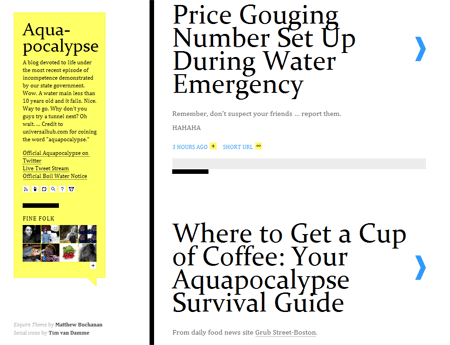Third in the Series: Here are the prior 2 article:
Someone just reminded me to put in the link — find Tumblr at www.tumblr.com
The conditions and uses for an instant Tumblr blog? How to “leverage” it for marketing purposes? Well, this is interesting. I think under the right circumstances it can used, but it is tricky. First, over all use:
- Tumblr would be a good option for a small business that wants a very personal, uncomplicated touch with a blog. Think of a small shop that wants a loyal fan base, not a 50-person company with a lot of products and services.
- It’s not a bad choice either for a bigger business with an existing “official” blog if individual employees want to share work-related experience — without going “off message” on the “official” blog.
- It could potentially be an off-shoot blog addressing a single-issue. Like dealing with a real-time crisis – even in a positive way.
- For instance, in the “Aquapocalypse” crisis in Boston, coffee availability was a prime concern voiced on Twitter. Not all coffee shops had enough bottled or clean water on hand to brew. By Monday there were literally hundreds of “tweets” about coffee availability and which stores had it.
- Imagine if a coffee shop with no blog or a simple business webpage had set up a blog on Tumblr about the coffee shortage — and could message users that they HAD coffee?
- How would it get seen? Simple – create a Twitter account by the same name. Tumblr can post automatically to Twitter.
- Hashtags, Hashtags, Hashtags. If you don’t know what a hashtag is look it up here. Think of them as single-topic communities on Twitter. Make sure you put the hashtag of the issue/audience in your blog posts so they show up on Twitter.
- Be careful though: Tumblr community is mostly young and very savvy. This is a two-edged sword. There will be a “coolness factor” you’ll have to meet. But don’t panic – the designs and templates will already get you half way to “cool.”
Final Word: Not only is Tumblr easy to use, with excellent functionality, its incredibly fun. Interaction with the community on Tumblr is fast and fun too. I wish, sincerely, that Facebook had one-tenth the usability as this platform.

